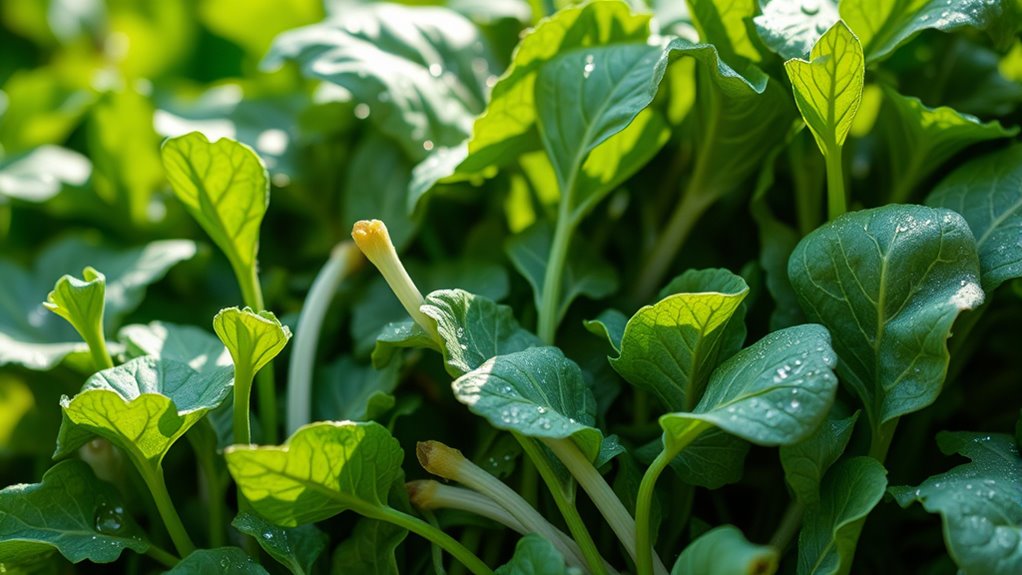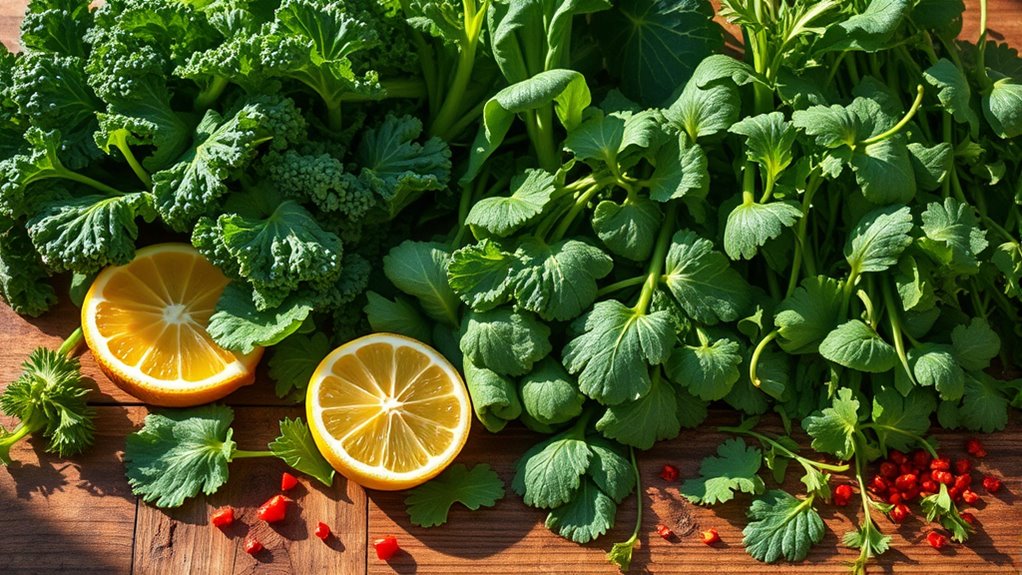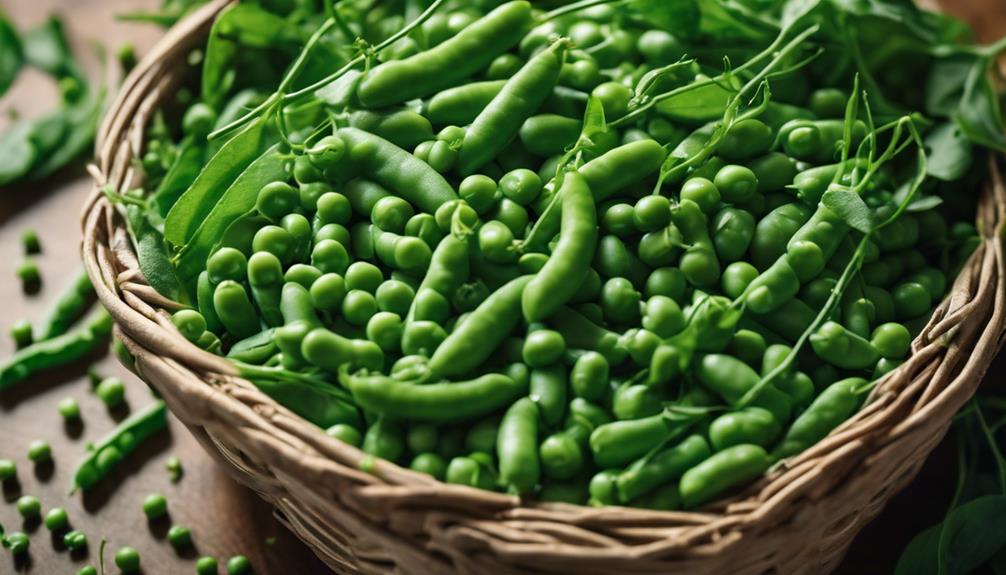To turn bitter wild greens into flavorful, detoxifying bites, start by blanching them briefly in boiling water to reduce bitterness. Enhance their taste with lemon juice, honey, or sauté them with garlic and onions. Pairing greens with olive oil or nuts can also boost flavor and palate appeal. As you experiment, you’ll learn techniques to make these nutrient-rich greens taste amazing, revealing their full health benefits—continue exploring to master their transformation.
Key Takeaways
- Use blanching to reduce bitterness and soften greens before adding flavor-enhancing ingredients.
- Incorporate lemon juice, honey, or salt to balance and mask natural bitterness.
- Sauté wild greens with garlic or onions to add depth and improve taste.
- Combine greens with hearty ingredients like nuts or olive oil to create more palatable dishes.
- Gradually introduce wild greens into your diet to adapt your palate and appreciate their detoxifying benefits.

Have you ever wondered how wild greens can help detoxify your body? These plants are packed with nutritional benefits that can support your health in ways many store-bought options can’t match. Wild greens like dandelion, chickweed, and purslane are rich in vitamins, minerals, antioxidants, and fiber. They help flush out toxins, improve digestion, and boost your immune system. Because they’re naturally growing in your environment, they often have a higher nutrient density than cultivated greens. Plus, incorporating these wild foods into your diet can be a rewarding foraging adventure that reconnects you with nature.
Wild greens like dandelion and purslane detoxify, nourish, and reconnect you with nature’s abundance.
When it comes to foraging tips, safety is key. First, learn to identify the right plants confidently. Use reputable guides or join local foraging groups to avoid confusion with toxic look-alikes. Always harvest from clean, pesticide-free areas, away from busy roads or industrial sites. When collecting greens, pick young, tender leaves, which tend to be milder and more palatable. Rinse them thoroughly to remove dirt, insects, or any residual impurities. Start with small quantities to see how your body reacts, especially if you’re new to wild greens. Incorporate them into your meals gradually—mixing with familiar ingredients can help your palate adapt and make the flavors more enjoyable.
Many wild greens have a naturally bitter taste, which can seem off-putting at first. However, you can turn that bitterness into a flavor advantage with some simple culinary tricks. Blanching greens briefly in boiling water reduces bitterness and softens their texture. Adding a splash of lemon juice, a drizzle of honey, or a sprinkle of salt can enhance their flavor profile and make them taste better. Sautéing with garlic or onions can also mask some of the bitterness while adding depth. Combining wild greens with richer ingredients like olive oil or nuts often balances their sharpness, transforming them into delicious additions to salads, soups, or smoothies.
The key to making wild greens taste amazing is to experiment with different prep methods and flavor pairings. Don’t let initial bitterness discourage you; instead, see it as a sign of their potent detoxifying properties. As you become more comfortable with their flavor, you’ll find ways to incorporate them seamlessly into your meals, turning a detoxifying superfood into a tasty, everyday ingredient. Paying attention to vacuum cleaner performance metrics such as filtration can help you understand how effectively your kitchen tools maintain a clean environment, which is especially important when handling wild edibles. With a little knowledge, some careful foraging, and creative cooking, you can enjoy the nutritional benefits of wild greens while savoring their new, improved flavors.
Frequently Asked Questions
Can Detoxifying Wild Greens Improve Their Nutritional Value?
Detoxifying wild greens can indeed improve their nutritional enhancement by reducing toxins that might hinder nutrient absorption. When you detoxify, you remove bitterness and potential contaminants, making the greens easier to digest and allowing your body to better absorb essential vitamins and minerals. This process not only enhances flavor but also boosts overall health benefits. So, yes, detoxifying wild greens is a smart step to maximize their nutritional value and promote wellness.
Are There Specific Wild Greens That Don’t Require Detoxification?
Some wild green varieties and edible species are naturally less bitter and don’t require detoxification. You can identify these by their milder taste and familiar appearance. For example, lamb’squarters and purslane are gentle, nutrient-rich options that often don’t need detoxing. Always make certain you correctly identify wild greens and verify they’re safe to eat, but these varieties tend to be more palatable straight from nature, making them a great choice for easy, healthy foraging.
How Long Should Wild Greens Be Soaked for Effective Detoxification?
Ever wonder how long you should soak wild greens for detox effectiveness? The secret lies in a simple trick: soak them for about 15-20 minutes. This duration helps reduce bitterness and removes toxins effectively, transforming tough greens into a delicious, healthy addition to your meal. Don’t rush—taking this small step guarantees you access the full benefits, making your greens taste better and work harder for your health.
Does Detoxifying Wild Greens Remove All Bitter Compounds Completely?
Detoxifying wild greens helps reduce their bitterness, but it might not remove all bitter compounds completely. You can use bitter masking techniques like soaking or blanching, which enhance flavor and make greens more palatable. These methods improve flavor and encourage you to enjoy wild greens regularly. Keep in mind, some bitterness adds nutritional benefits, so aim for a balance between detoxification and preserving those healthy compounds.
Are There Any Risks Associated With Eating Wild Greens After Detoxification?
You might wonder about wild greens safety after detoxification, but the process mainly reduces bitterness and toxins, not all compounds. Detoxification myths often exaggerate risks; when done properly, wild greens are safe to eat. Just make certain you identify the plants correctly, wash thoroughly, and follow trusted detox methods. This way, you enjoy the nutritional benefits without concern, turning bitter greens into a tasty, healthy addition to your diet.
Conclusion
So, after all that, you might find it amusing how those bitter wild greens, once dreaded, can turn into your favorite bite. It’s funny, isn’t it? You spend time detoxifying and balancing flavors, only to realize the real magic was within the greens all along. Sometimes, the effort to tame bitterness reveals that nature’s most rebellious plants can become your tastiest, most rewarding surprise—if you’re willing to give them a chance. Who knew?










